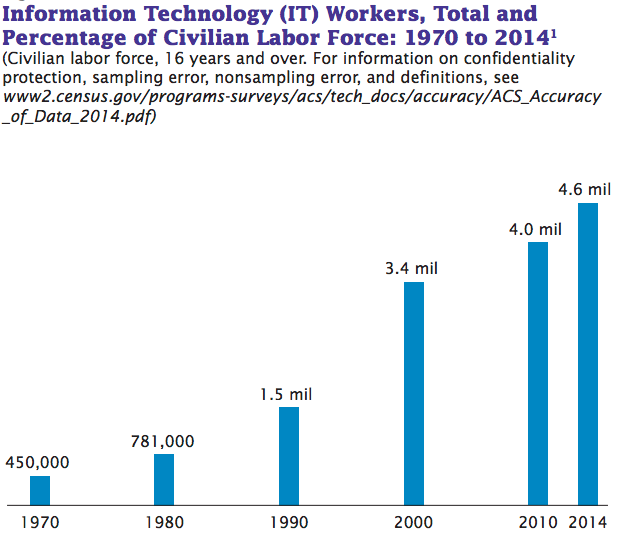
Men have always held the majority of tech jobs in the United States, but in 1990 it looked like women were making headway. Women held 31 percent of all tech jobs back then, a percentage that was steadily rising, according to a new report from the United States Census Bureau.
Then the industry boomed. The number of jobs in information technology increased tenfold to 4.6 million between 1970 and 2014. Thanks to the internet, the number of different types of jobs exploded. Pay grew, too.
And something funny happened. The percentage of women in tech declined. By 2014, just a quarter of these workers were women. That’s despite the fact that increasing numbers of women were joining the U.S. workforce.

What’s up? A lot has been written already about a long-standing bias against women in tech that starts when girls are young and never really stops.
But, to paraphrase the Republican candidate for president: Something else is going on. When a career becomes more prestigious, women don’t fare very well.
Claire Cain Miller wrote about this in The New York Times earlier this year. But she focused on the opposite end: When women enter male-dominated fields, she reported, pay in that field declines. When more women started working in recreation (parks or camps) between 1950 and 2000, hourly wages fell 57 percent, according to a study she cites in the article.

When a job becomes dominated by women, “It just doesn’t look like it’s as important to the bottom line or requires as much skill, ” Paula England, a sociology professor at New York University, told the Times. “Gender bias sneaks into those decisions.”
The reverse also holds, as the story noted at the time. When men enter female-dominated fields, pay in that field rises. In the case of IT workers, women never were a majority, yet as the number of jobs grew and the prestige of the industry increased, more men came on board and essentially took over. The percentage of women in IT fell.

So, to sum up: When women enter a field, its perceived value suffers a decline; when men enter a field, it grows in prestige.
Gradually, the image of the ideal tech worker has become that of a white guy in a hoodie working nonstop at a computer. Women have become increasingly alienated from that scenario.
H/T Fast Company
